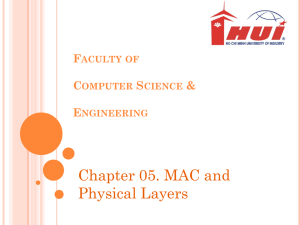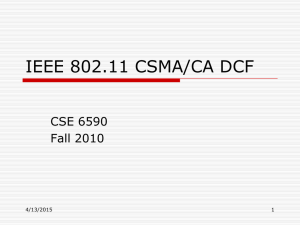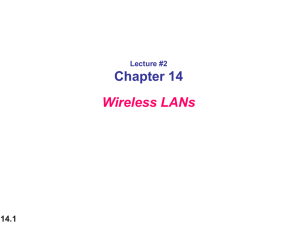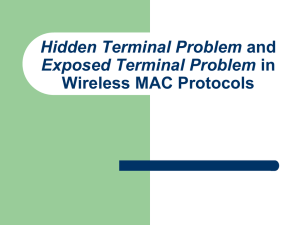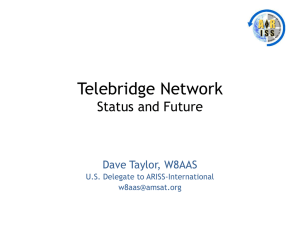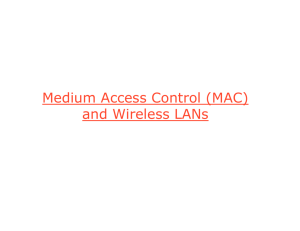From DS = 1
advertisement
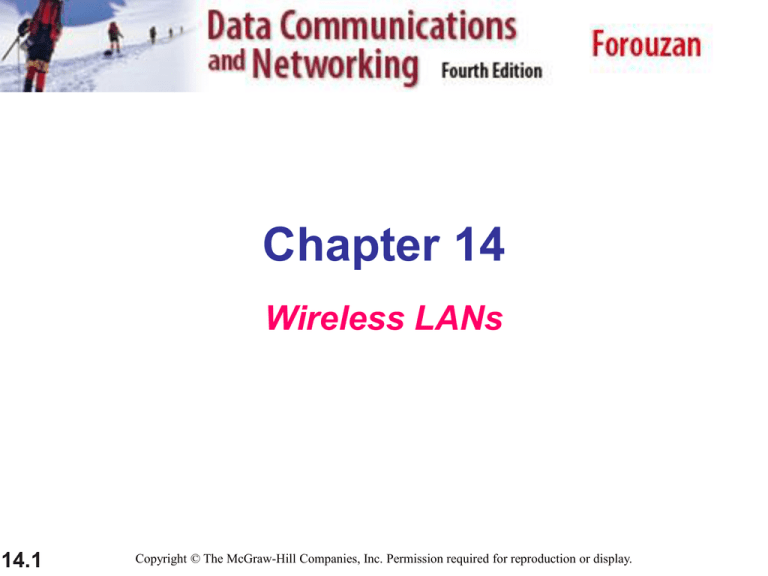
Chapter 14 Wireless LANs 14.1 Copyright © The McGraw-Hill Companies, Inc. Permission required for reproduction or display. 14-1 IEEE 802.11 IEEE has defined the specifications for a wireless LAN, called IEEE 802.11, which covers the physical and data link layers. Topics discussed in this section: Architecture MAC Sublayer Physical Layer 14.2 Architecture Provide two kinds of services The Basic Service Set 14.3 The Basic Service Set (BSS) The Extended Service Set (ESS) Made up of stationary or mobile wireless station and the access point (AP) The BSS is categories by without AP and with AP Note A BSS without an AP is called an ad hoc network; a BSS with an AP is called an infrastructure network. 14.4 The BSS without AP 14.5 This is a stand-alone network Cannot send a data among BSSs They can locate one another and agree to be part of a BSS Figure 14.1 Basic service sets (BSSs) 14.6 Extended Service Set Made up of two or more BSSs with APs The BSS are connected through a distribution system The distribution system connect APs in the BSSs The stations can be 14.7 Mobile – normal station in a BSS Stationary – refers as AP stations where it is part of wired LAN Figure 14.2 Extended service sets (ESSs) 14.8 Station Types IEEE 802.11 defines three types based on mobility in a wireless LAN : No transition BSS-transition Move from one BSS to another BUT the movement is inside one ESS ESS-transition 14.9 Not moving Moving only inside a BSS Move from one ESS to another MAC Sublayer IEEE 802.11 defines two MAC Sublayers Figure 14.3 shows the relationship between two MAC sublayers 14.10 DCF (Distributed Coordination Function) PCF (Point Coordination Function) The LLC sublayer The physical layer Figure 14.3 MAC layers in IEEE 802.11 standard 14.11 DCF (Distribution Coordination Function) Uses CSMA/CA as access method Why not CSMA/CD ? 14.12 When collision is detected, a station must be able to send and receive a collision signal at the same time. This can mean costly station and increased bandwidth requirements If there are the hidden station problems, a collision may not be detected The distance between stations are great so signal fading could prevent from hearing a collision Figure 14.4 CSMA/CA flowchart 14.13 CSMA/CA Flowchart Before sending a frame 14.14 Uses Persistence strategy with back-off until the channel idle If the channel is idle, wait for a period of time called the DIFS (Distributed Interframe Space) Sends the control frame called the RTS (Request To Send) Continue … After received the RTS 14.15 Waiting a period of time called the SIFS (Short Interframe Space) The destination station sends a control frame called the CTS (Clear To Send) to the source station This control frame indicates the destination station is ready to receive a data Continue … After waiting an amount of time equal to SIFS, the source station starts send a data At destination station 14.16 After waiting an amount of time equal to SIFS, send an acknowledgement** to show the time frame is received **Acknowledgement is the way to inform about arrival packet of data Figure 14.5 CSMA/CA and NAV 14.17 NAV (Network Allocation Vector) How do other stations defer sending their data if one station acquires access? In other words, how is the collision avoidance aspect of this protocol accomplished? The key is a feature called NAV. 14.18 Continue .. When a station send the RTS frame Collision during handshaking 14.19 It includes the duration of occupy for the channel This station create a timer called NAV that shows how much time must pass before other stations are allowed to check the channel for idleness It is happened during when RTS and CTS are in transition Uses back-off strategy and sender tries again PCF (Point Coordination Function) 14.20 Optional access method and can be implemented in an infrastructure network It is also implemented on top of DCF Mostly used for time-sensitive transmission Continue … PCF has a centralised and contention-free polling access The AP performs polling for the stations and the stations sending data to the AP To set priority to PCF, interframe spaces have been defined 14.21 PIFS – shorter than the DIFS SIFS – Same as that in DIFS Example : at the same time, (1) a station wants use only DCF, (2) AP wants use PCF, so as a result the AP has priority Continue … Due to priority of PCF over DCF, stations only use DCF may not access to the medium To prevent this, a repetition interval has been designed to cover 14.22 Contention-free (PCF) Contention-based (DCF) Continue … The repetition interval which is repeated continuously as shown in Figure 14.6 It is start with a special control frame (beacon frame) 14.23 When the stations hear a beacon frame It starts the NAV during contention-free period Figure 14.6 Example of repetition interval 14.24 Continue … During the repetition interval 14.25 The PC sends a pool frame The PC receives data The PC sends ACK or receives ACK or do any combination of these At the end, the PC sends CF end (contentionfree end) frame to allow the contention-based stations use the medium Fragmentation 14.26 A corrupt frame has been retransmitted due to noisy in the wireless environment Therefore, recommends fragmentation of large frame It is more efficient to resend a small frame than a large one Frame Format The MAC layer consists of nine fields as shown in Figure 14.7 14.27 FC (Frame Control) – defines the type and control information D – defines the duration of the transmission Addresses – defines there are 4 addresses SC (sequence control) – defines sequence number of the frame Frame body – defines the types and subtypes of FC field FCS – defines error detection sequence using CRC-32 scheme Figure 14.7 Frame format 14.28 Table 14.1 Subfields in FC field 14.29 Frame Types A wireless LAN defined by IEEE 802.11 has three categories of frames Management Frames Control Frames Used for accessing the channel and acknowledging the frame as shown in Figure 14.8 Data Frames 14.30 Used for initial communication between stations and APs Used for carrying data and control information Figure 14.8 Control frames 14.31 Table 14.2 Values of subfields in control frames 14.32 Addressing Mechanism 14.33 Specifies four cases by defining the value of the two flags in the FC field such To DS and From DS as shown in Table 14.3 The interpretation of the four addresses (address 1 to address 4) in the MAC frame depends on the value of these flags Note : Address 1 is always the address of the next device; Address 2 is always the address of the previous devices; Address 3 is the address of the final station if it is not defined by address 1; Address 4 is the address of original source station if it is not same as address 2 Table 14.3 Addresses 14.34 Case 1 : 00 (refers to Table 14.3) 14.35 To DS = 0 ; The frame is not going to to a distribution system From DS = 0 ; The frame is not coming from a distribution system The frame is going from one station in a BSS to another without passing through the distribution system as shown in Figure 14.9 (a) Figure 14.9 Addressing mechanisms 14.36 Case 2 : 01 14.37 To DS = 0 and From DS = 1; the frame is coming from a distribution system (AP) and going to the station (original) The ACK frame should be sent to the AP Note : the address 3 contains the original sender of the frame (in another BSS) as shown in Figure 14.9 (b) Case 3 : 10 14.38 To DS = 1 and From DS = 0; The frame is going to the distribution system (AP) from the station The ACK frame is sent to the original station Note : Address 3 contains the final destination of the frame (in another BSS) as shown in Figure 14.9 (c) Case 4 : 11 14.39 To DS = 1 and From DS = 1; The frame is going from one AP to another AP in a wireless distribution system Do not to define addresses if the distribution system is a wired LAN because the frame in these cases has the format of wired LAN frame (Ethernet) Note : need four addresses to define the original sender, the final destination and two intermediate APs as shown in Figure 14.9 (d) Hidden and Exposed Station Problems Based on Figure 14.10, Station A can hear a signal transmitted by B or C Assume; 14.40 Station B is sending a data to station A In the middle, station C also sends data to station A However, station C is out of B’s range and transmission from B cannot reach C Therefore, C thinks the medium is free Station C sends data to A which results in a collision at A because station A receiving data from both B and C Figure 14.10 Hidden station problem 1 14.41 2 Continue … 14.42 In this case, station B and C are hidden between each other with respect to A Hidden stations can reduce the capacity of the network because of the possibility of collision The solution is the handshake frames (RTS and CTS) as shown in Figure 14.11 where the RTS message from B reaches A but not C Station C knows some hidden station is using the channel and refrains from transmitting until duration is over Note The CTS frame in CSMA/CA handshake can prevent collision from a hidden station. 14.43 Figure 14.11 Use of handshaking to prevent hidden station problem 14.44 Exposed Station Problem 14.45 In this problem, a station is refrain from using a channel when it is available Figure 14.12 shows station A is transmitting to station B Station C has a data to send to station D which can be sent without interfering with the transmission from A to B However, station C is exposed to transmission from A; station C hears what A is sending and refrains from sending Station C is too conservative and wastes the capacity of the channel Figure 14.12 Exposed station problem 14.46 Handshaking 14.47 Station C hears the RTS from A but does not hear the CTS from B Station C, after hearing the RTS from A, can wait for a time so that the CTS from B reaches A It then sends the RTS to D to show that it needs to communicate with D Both station B and A may hear this RTS but station A is in the sending state, not the receiving state Station B, however, responds with a CTS Continue …. 14.48 The problem begun, if station A has started sending its data Station C cannot hear the CTS from station D because of the collision Station C cannot send its data to D Station C remains exposed until A finishes sending its data as shown in Figure 14.13 Figure 14.13 Use of handshaking in exposed station problem 14.49 Physical Layer Except the infrared, all implementations are operate in the industrial, scientific and medical (ISM) band which defines three unlicensed bands in the three ranges 14.50 902-928 MHz 2.400 – 4.835 GHz 5.725 – 5.850 GHz See Figure 14.14 Table 14.4 Physical layers 14.51 Figure 14.14 Industrial, scientific, and medical (ISM) band 14.52 14-2 BLUETOOTH Bluetooth is a wireless LAN technology designed to connect devices of different functions such as telephones, notebooks, computers, cameras, printers, coffee makers, and so on. A Bluetooth LAN is an ad hoc network, which means that the network is formed spontaneously. Topics discussed in this section: Architecture Bluetooth Layers Baseband Layer L2CAP 14.53 Architecture Defines two type of networks McGraw-Hill Piconet Scatternet 14.54 ©The McGraw-Hill Companies, Inc., 2000 Piconet 14.55 It is also called small net Its can have up to 8 stations One primary, the rest are secondary Communication can be one-to-one or oneto-many Continue .. 14.56 An additional eight secondaries can be in the “parked state” A secondary in a “parked state” is synchronised with the primary but cannot take part in communication until it is moved from the “parked state” ONLY eight stations can be active To activate a station from the “parked state”, an active station must go to the “parked state” Figure 14.19 Piconet 14.57 Scatternet 14.58 It has been formed by the combinations of piconet A secondary station in one piconet can be the primary in another piconet This station can receive messages from the primary in the first piconet (as a secondary) and acting as a primary, deliver them to secondaries in the second piconet A station can be a member of two piconets Figure 14.20 Scatternet 14.59



